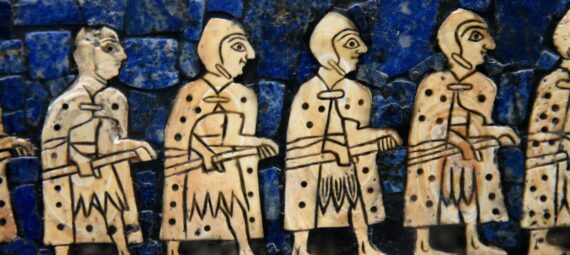In the study of ancient names, scholars often wrestle with uncertainty. When records are fragmentary or languages extinct, researchers must infer connections using a mix of linguistic, historical, and contextual reasoning. But that uncertainty also demands careful methodological restraint — especially when a theory involves reconstructing phonetic or semantic links across thousands of years and multiple civilizations.
One recent line of research, by Jerry Grover, has proposed that certain names in the Book of Mormon derive from Sumerian roots, carried through the Jaredite civilization and preserved in later Nephite usage. The hypothesis is ambitious, but the methodological process used to “reconstruct” those names raises important questions about how far etymological inference can be stretched before it becomes interpretive speculation.
How the Method Works
The approach begins by taking a name from the Book of Mormon — for example, Deseret or Irreantum — and then searching the electronic Pennsylvania Sumerian Dictionary (ePSD) for Sumerian morphemes (root syllables) that resemble parts of the name. Each of those morphemes is associated with a gloss or meaning (“to carry,” “bee,” “water,” etc.). The researcher then combines these morphemes into a “constructed compound,” selecting those whose meanings seem to align with the context of the scriptural passage.
For instance, Deseret (defined in the text as “honey bee”) might be broken into de-sa-re, each syllable corresponding to Sumerian morphemes meaning “to carry,” “to sting,” and “to go.” When those meanings are arranged creatively, they can be read as “to go carrying a stinging insect.” The similarity between the English spelling and the transliterated Sumerian syllables is then presented as evidence of a common origin.
At first glance, this process appears linguistically informed — it uses real Sumerian entries and references known semantics. But beneath the surface, the method functions less like linguistic reconstruction and more like semantic pattern matching.
Sumerian Morphemes Don’t Work That Way
To understand why this approach fails linguistically, it helps to recall how Sumerian morphology actually functions.
Agglutinative but rule-bound
Sumerian is an agglutinative language — it builds words by stringing together morphemes, but each affix has a specific position and grammatical function. For example, in the verb mu-na-gub-be₂-en (“he placed it for her”), the prefixes follow a strict order: [ventive] + [dative] + [root] + [object marker] + [subject marker]. You cannot rearrange or freely combine morphemes; the structure encodes syntax.
Lexical compounding is limited
When Sumerian does form new nouns or compounds, it follows patterns such as:
- [Noun + Noun] → determinative or attributive (“house” + “fish” = “fishpond”)
- [Verb + Noun] → deverbal noun (“to build” + “place” = “temple”)
- [Noun + Adjective] → descriptive compound (“king” + “great” = “great king”)
These combinations are attested in texts and follow clear syntactic logic. You cannot just glue arbitrary roots together because their English glosses happen to make sense. Each element must occur in a grammatical slot with the correct morphology and often undergoes phonological reduction (assimilation, vowel harmony, deletion).
Homography and glossing issues
Most Sumerian morphemes have multiple meanings and context-dependent readings. For example, DU can mean “to go,” “to build,” or “to erect,” depending on the determinatives and syntax. The English glosses in ePSD are not interchangeable semantic puzzle pieces — they are interpretive summaries of context-specific uses.
In short: Sumerian morphology is compositional but not combinatorial. You can’t just stack roots like Lego bricks; their order, function, and grammar matter.
Why the Examples Don’t Work
1. Deseret
The proposed derivation for Deseret breaks the word into syllables that are said to match Sumerian morphemes:
- de = “to carry,”
- sa = “to sting,”
- re = “to go,”
and sometimes a final t is treated as a nominal ending.
Attractive as that might appear, this construction fails on several linguistic grounds.
Missing morphological structure
Sumerian verbs require prefixal and suffixal morphology to express relations between actions, agents, and objects. Multiple verbal stems cannot be strung together directly. If one truly wanted to express “to go carrying a stinging insect,” a Sumerian phrase would need verbal chaining markers or subordination particles (such as -a, -ta, -še, -da). A raw concatenation like de-sa-re omits these connectors entirely — it is not grammatical Sumerian, but simply three infinitives jammed together.
Category conflict
All three proposed morphemes (de, sa, re) are verbal roots, not nouns or adjectives. Sumerian compounding rules require a head noun to which modifiers attach. You can form compounds like e₂-gal (“palace,” literally “house–great”) or lugal-meš (“kings,” pluralized), but not “carry–sting–go.” Even in verbal noun formation, each verb must be nominalized with -a or -e before it can serve as part of a compound (du₃-a = “the act of building”). None of that occurs in Deseret.
Phonotactic problems
Sumerian roots rarely end with -e followed by a dental stop -t. That pattern is typical of later Akkadian or Northwest Semitic orthography, not Early Dynastic Sumerian. The final -t in Deseret therefore looks like an English or Hebrew orthographic element rather than a genuine Sumerian inflection.
What a real “bee” term would look like
Sumerian expresses species or collective nouns through noun–noun compounds, not strings of verbs.
For example:
- nim-maš (“eagle”) combines nim “high” + maš “bird,”
- mus-gi₆ (“black snake”) combines mus “snake” + gi₆ “black.”
Following that logic, a Sumerian term for “bee” would take a form like mus-lal₃ (“buzzing insect”) or kus-sa (“stinging thing”) — not de-sa-re. Thus, the Deseret construction fails both structurally and typologically.
2. Irreantum
The name Irreantum, glossed in the Book of Mormon as “many waters,” presents even greater linguistic problems. In the Sumerian framework, a plausible equivalent for “many waters” would require at least two semantic components — one meaning “many” or “great,” and another meaning “water.” However, the proposed form Irreantum cannot be analyzed as a valid Sumerian compound for several reasons.
Missing grammatical markers
Sumerian compounds and phrases normally require case or relational markers to connect elements. For example:
- a gal₂-la (“great water”) uses -la as an attributive genitive marker;
- a-ĝal₂-la-ke₄ (“of the great waters”) uses -ke₄ as an ergative or genitive postposition.
In contrast, Irreantum contains no morphological markers that indicate genitive, attributive, or relational structure. The sequence of syllables (ir–re–an–tum) reads as a continuous chain with no suffixes like -a, -ak, -ta, or -e, all of which are obligatory in Sumerian to show possession, relation, or modification.
Without these markers, Sumerian roots cannot connect grammatically — they remain independent lexemes.
Incompatible morphemes
The components implied by the spelling also do not cohere phonologically or morphologically:
- ir can mean “copper,” “lament,” or “fragrance,” depending on determinative context — none relate to “many” or “water.”
- an means “heaven,” “sky,” or acts as a divine determinative, but it cannot modify a (“water”) without a genitive marker (an-a → “of heaven”).
- tum functions as a verbal suffix meaning “to bring” or as part of participial formations (e.g., -tum₂), not as a nominal or adjective meaning “many.”
No valid compounding pattern
For “many waters,” a grammatical Sumerian construction would likely resemble a gal₂-la or a meš (“waters,” plural), or possibly a gal₂-meš (“great waters”). Each of these examples uses explicit morphological devices — plural markers (-meš) or attributive suffixes (-la). The form Irreantum lacks any such morphology. It is effectively a string of open syllables without relational markers, grammatical suffixes, or consistent root meanings.
Even if we attempt to treat -tum as a nominalizing suffix borrowed from Akkadian, the preceding sequence irrean- would still violate Sumerian morphotactics: Sumerian roots are monosyllabic (CVC) or disyllabic (CVVC/CVCV), not polysyllabic clusters. There is no mechanism in the language for a four-syllable chain like ir-re-an-tum to form a coherent compound without connective morphology.
Result
What remains is not a linguistic reconstruction but a surface resemblance — a string that looks ancient but follows none of Sumerian’s grammatical conventions. The absence of case markers (-ak, -a, -e) and the mixing of incompatible roots (ir, re, an, tum) all indicate that Irreantum cannot be parsed as Sumerian in either structure or meaning.
The Logographic Gap
The method also assumes that Jaredite and Nephite scripts were logographic, meaning that they recorded meanings rather than sounds. But if the original writing preserved only semantic content, then the phonetic form of a word like Irreantum could not have survived. Reconstructing a phonetic form from a logogram is not linguistics — it’s creative translation. The result might have symbolic resonance, but it cannot be verified historically.
A Matter of Method, Not Motive
This critique is not about belief or intent. The effort to uncover linguistic patterns in scripture reflects genuine curiosity. But even well-intentioned scholarship must be judged by methodological clarity. If a process allows any name to be broken into arbitrary syllables and reassembled from a vast database of roots until a desired meaning emerges, then the method becomes self-validating. It tells us more about the researcher’s interpretive freedom than about the structure of Sumerian.
Why Methodology Matters
Linguistic reconstruction is powerful precisely because it imposes constraints: regular sound correspondences, syntactic rules, and falsifiable hypotheses. Without those, the “creation” of Sumerian-looking names is a semantic exercise, not a linguistic one.
Sumerian compounding obeyed fixed grammatical patterns; the method in question treats it as a free combinatorial code. That difference is decisive — it separates linguistic reconstruction from interpretive composition.
Creative exploration of ancient language is valuable, and interdisciplinary imagination should be encouraged. But in the end, the integrity of such work depends on its method. When morphemes are freely rearranged to produce a desired meaning, the result becomes literary rather than linguistic — a reflection of interpretation, not inheritance.
Sumerian offers a profound record of human expression, but it also demands respect for its internal logic. Its morphemes do not simply combine; they conform. Any attempt to use Sumerian as a key to other texts must start there.





